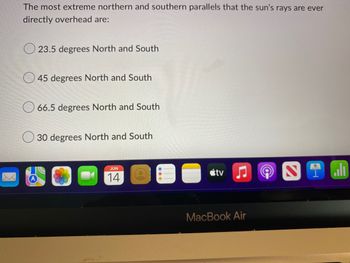
Applications and Investigations in Earth Science (9th Edition)
9th Edition
ISBN: 9780134746241
Author: Edward J. Tarbuck, Frederick K. Lutgens, Dennis G. Tasa
Publisher: PEARSON
expand_more
expand_more
format_list_bulleted
Question
17

Transcribed Image Text:**Educational Website Content:**
### Understanding the Tropics and the Earth's Axial Tilt
**Quiz Question:**
The most extreme northern and southern parallels that the sun’s rays are ever directly overhead are:
- 23.5 degrees North and South
- 45 degrees North and South
- 66.5 degrees North and South
- 30 degrees North and South
**Explanation:**
The options provided in this question help us understand the key latitudinal lines on the Earth where the sun can be directly overhead at some point during the year. Here's a breakdown of each option:
1. **23.5 degrees North and South:**
- This represents the Tropic of Cancer in the Northern Hemisphere and the Tropic of Capricorn in the Southern Hemisphere. These are the most extreme latitudes where the sun can be directly overhead. This occurs due to the tilt of the Earth’s axis (approximately 23.5 degrees) in relation to its orbit around the sun. Around June 21st, the sun is directly over the Tropic of Cancer, marking the summer solstice in the Northern Hemisphere. Around December 21st, the sun is directly over the Tropic of Capricorn, marking the summer solstice in the Southern Hemisphere.
2. **45 degrees North and South:**
- This option does not correspond to any major latitudinal lines where the sun is directly overhead.
3. **66.5 degrees North and South:**
- This represents the Arctic Circle in the Northern Hemisphere and the Antarctic Circle in the Southern Hemisphere. These areas are known for experiencing at least one day with 24 hours of daylight (midnight sun) and one day with 24 hours of darkness (polar night) each year.
4. **30 degrees North and South:**
- This option does not correspond to any specific latitudinal significance regarding the sun’s direct overhead position.
**Correct Answer: 23.5 degrees North and South**
**Note:**
The diagram or image associated with this text shows a list of options with corresponding radio buttons beside each option, from which the user can select their answer. This visual representation indicates an interactive quiz setup on the educational website. The taskbar at the bottom suggests the content is displayed on a MacBook Air.
Expert Solution
This question has been solved!
Explore an expertly crafted, step-by-step solution for a thorough understanding of key concepts.
Step by stepSolved in 2 steps with 1 images

Knowledge Booster
Recommended textbooks for you
 Applications and Investigations in Earth Science ...Earth ScienceISBN:9780134746241Author:Edward J. Tarbuck, Frederick K. Lutgens, Dennis G. TasaPublisher:PEARSON
Applications and Investigations in Earth Science ...Earth ScienceISBN:9780134746241Author:Edward J. Tarbuck, Frederick K. Lutgens, Dennis G. TasaPublisher:PEARSON Exercises for Weather & Climate (9th Edition)Earth ScienceISBN:9780134041360Author:Greg CarbonePublisher:PEARSON
Exercises for Weather & Climate (9th Edition)Earth ScienceISBN:9780134041360Author:Greg CarbonePublisher:PEARSON Environmental ScienceEarth ScienceISBN:9781260153125Author:William P Cunningham Prof., Mary Ann Cunningham ProfessorPublisher:McGraw-Hill Education
Environmental ScienceEarth ScienceISBN:9781260153125Author:William P Cunningham Prof., Mary Ann Cunningham ProfessorPublisher:McGraw-Hill Education Earth Science (15th Edition)Earth ScienceISBN:9780134543536Author:Edward J. Tarbuck, Frederick K. Lutgens, Dennis G. TasaPublisher:PEARSON
Earth Science (15th Edition)Earth ScienceISBN:9780134543536Author:Edward J. Tarbuck, Frederick K. Lutgens, Dennis G. TasaPublisher:PEARSON Environmental Science (MindTap Course List)Earth ScienceISBN:9781337569613Author:G. Tyler Miller, Scott SpoolmanPublisher:Cengage Learning
Environmental Science (MindTap Course List)Earth ScienceISBN:9781337569613Author:G. Tyler Miller, Scott SpoolmanPublisher:Cengage Learning Physical GeologyEarth ScienceISBN:9781259916823Author:Plummer, Charles C., CARLSON, Diane H., Hammersley, LisaPublisher:Mcgraw-hill Education,
Physical GeologyEarth ScienceISBN:9781259916823Author:Plummer, Charles C., CARLSON, Diane H., Hammersley, LisaPublisher:Mcgraw-hill Education,

Applications and Investigations in Earth Science ...
Earth Science
ISBN:9780134746241
Author:Edward J. Tarbuck, Frederick K. Lutgens, Dennis G. Tasa
Publisher:PEARSON

Exercises for Weather & Climate (9th Edition)
Earth Science
ISBN:9780134041360
Author:Greg Carbone
Publisher:PEARSON

Environmental Science
Earth Science
ISBN:9781260153125
Author:William P Cunningham Prof., Mary Ann Cunningham Professor
Publisher:McGraw-Hill Education

Earth Science (15th Edition)
Earth Science
ISBN:9780134543536
Author:Edward J. Tarbuck, Frederick K. Lutgens, Dennis G. Tasa
Publisher:PEARSON

Environmental Science (MindTap Course List)
Earth Science
ISBN:9781337569613
Author:G. Tyler Miller, Scott Spoolman
Publisher:Cengage Learning

Physical Geology
Earth Science
ISBN:9781259916823
Author:Plummer, Charles C., CARLSON, Diane H., Hammersley, Lisa
Publisher:Mcgraw-hill Education,